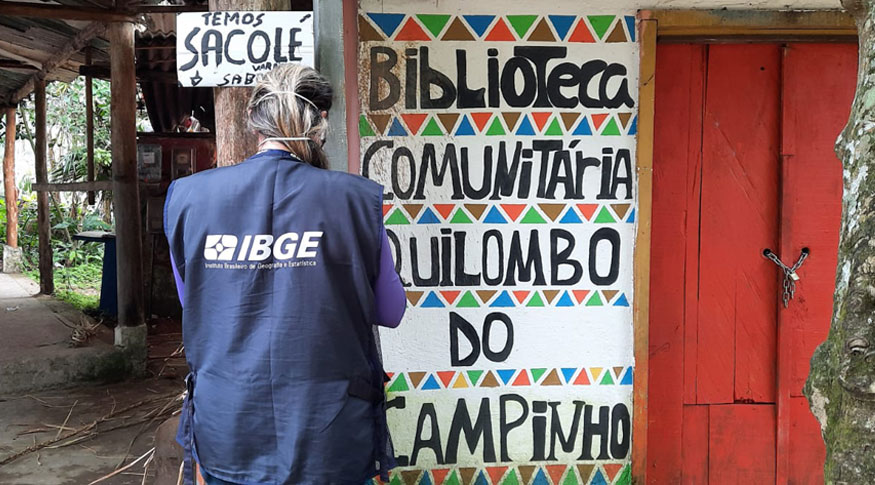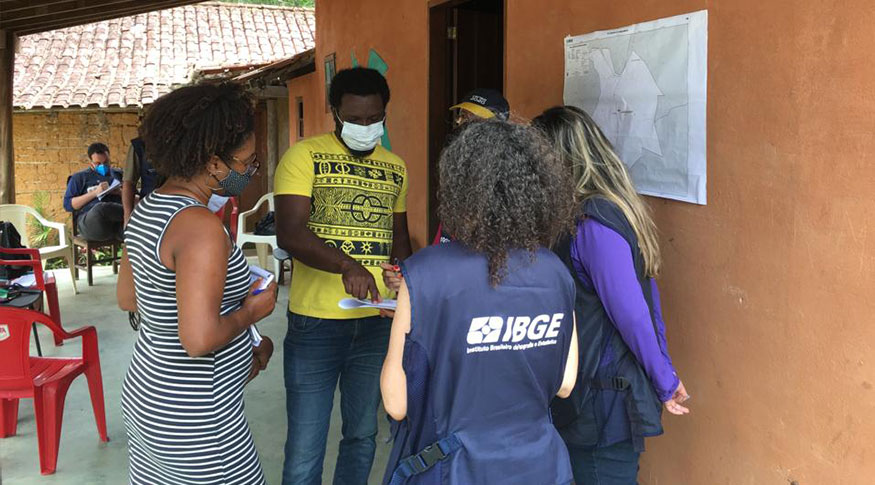2022 Census
Census National Test reaches Quilombola Community in Paraty (RJ) (3)
November 24, 2021 11h30 AM | Last Updated: November 25, 2021 05h58 PM
Highlights
- The test in the Quilombola Territory of Campinho da Independência, in Paraty (RJ) will evaluate health protocols, standards of conduct and approach, data collection procedures and geographic coordinates.
- The tests in traditional peoples and communities also took place in the Indigenous lands of Guaramim do Bracuí, in Angra dos Reis (RJ); Rio Pequeno and Parati-Mirim and the Pataxós' village, in Paraty.
- Quilombola areas have a specific questionnaire, and it is necessary to test whether the collection application is correctly capturing the coordinates of the households.
- Collection in quilombola territories requires meetings with community leaders explaining what the IBGE is, what the Census is and what will be done in the communities.
- The IBGE also carried out tests in Paquetá (RJ) and in 27 locations during the 2022 National Census Test, which began on November 4 in all state branches.
The IBGE is carrying out today (24) the 2022 Census National Test in the Quilombo of Campinho da Independência, in Paraty, in the south of the state of Rio de Janeiro. After intensive consultation work with quilombola leaders, the test will evaluate specific sanitary protocols, standards of conduct and approach, collection procedures, geographic coordinates and questions that will be asked only to these populations. It is the first time that people will be able to identify themselves as Quilombolas in the Population Census.
“It's a dress rehearsal, we're just testing the systems. The questions already contain the wording that we hope will be applied in 2022. In fact, the test is only for the last adjustments”, says the technical responsible for the project of traditional peoples and communities at IBGE, Ms. Marta Antunes.
Tests with traditional peoples and communities began on November 15, with the census of the Indigenous Lands of Guarani do Bracuí, in Angra dos Reis (RJ); Rio Pequeno and Parati-Mirim and Pataxós' village, all in Paraty. This Wednesday, the test ends with the census of the quilombola territory. .

“During these days, we have tested the post-pandemic work: protection equipment, distancing and how communities and their leaders respond to it all. We have also tested the face-to-face training for those who will work in Quilombola areas, concerning norms and cultures. Enumerators need to know how to approach people, reaching community leaders and deciding whether a guide is necessary, or, for Indigenous lands, whether a translator is required. We have also created support material for each question to help enumerators, in case Quilombola or Indigenous people cannot understand the questionnaire. All is taught in a special day of training. That training can be applied for the entire country”, says Ms. Marta Antunes.
Today the IBGE estimates that there are more than 5 thousand Quilombola areas. The information is taken from the geographic and statistical database. Ms. Antunes claims that there is a very diverse Quilombola presence all over the country, except in the states of Acre and Roraima, which lack them. It is an even greater diversity compared to Indigenous communities. There are more than 2 thousand municipalities with Quilombola areas against a little more than 500 with Indigenous lands.
“The IBGE census cartography allows visibility to the Quilombola presence in more than 2 thousand municipalities, which is extremely important information for a group that had neither official statistics nor official estimates. It was a joint work carried out by all state branches coordinated by the Directorate of Geosciences, through a dialogue with the Quilombola social movement. A great experience of collaborative census cartography”, highlights Ms. Antunes.
She explains that Quilombola areas have a questionnaire only available for some country areas, and it is necessary to test if the application is correctly capturing the household coordinates so that the specific questions can be activated. So, a positioning test will also be carried out in the field.
“The questions of the household questionnaire of the IBGE have a different wording according to the localization. If the household is in a Quilombola or Indigenous area, the questions change. In all Quilombola territories, we will ask, for instance, if respondents consider themselves Quilombolas. This is the first time that the IBGE will ask such a question in a population census. And it will be the first time we will have official statistics on the total Quilombola population in the country and their living conditions, where they are and how they live”, Ms. Antunes emphasizes.
Thanks to the contact between the IBGE and Quilombola associations and the awareness campaign on the fact that this is the first Census in which people will be able to self-declare as Quilombola, the expectations of significant results are high.
“As in all enumeration processes, this one is an educational process too. The first result might not be great, but if it stands below expectations, it will trigger a debate for the next decade”, says Ms. Antunes.
The data collection also requires a whole set of specific approach procedures of the 2022 Census. It involves meetings with community leaders explaining what the Ibge is, what the Census is and what will be done in the community.
“E ask for the support of leaders to start our work, which will comprise the interview with the household questionnaire and an evaluation to check if everything went as expected. Afterwards, some coordinate capture tests will be carried out for addresses and, at the end of the day, general results will be presented to the leaders”, says Ms. Antunes.

The IBGE also carried out tests on the Paquetá Island (RJ) and in 27 localities during the 2022 Census National Test, which started off on November 4 in all state branches. Up to the end of November, 250 enumerators from the IBGE will be visiting households to test the equipment, collection systems and the way to approach respondents in the context of the pandemic. From June next year on, the IBGE will be in the field to enumerate more than 70 million Brazilian households.
How to check interviewers’ identity
IBGE enumerators wear a uniform, with a blue cap, blue vest and blue bag with the Institute’s logo on them. On the vest, there is also the identification badge, with the interviewer’s picture, identification number and ID. They will be holding a blue collection device, similar to a smartphone, to get the information. All residents can check the enumerators’ ID on the respondendo.ibge.gov.br website or by calling 0800 721 8181.
As in all the IBGE surveys, the information given by residents to the enumerators are confidential and secrecy is guaranteed.


















